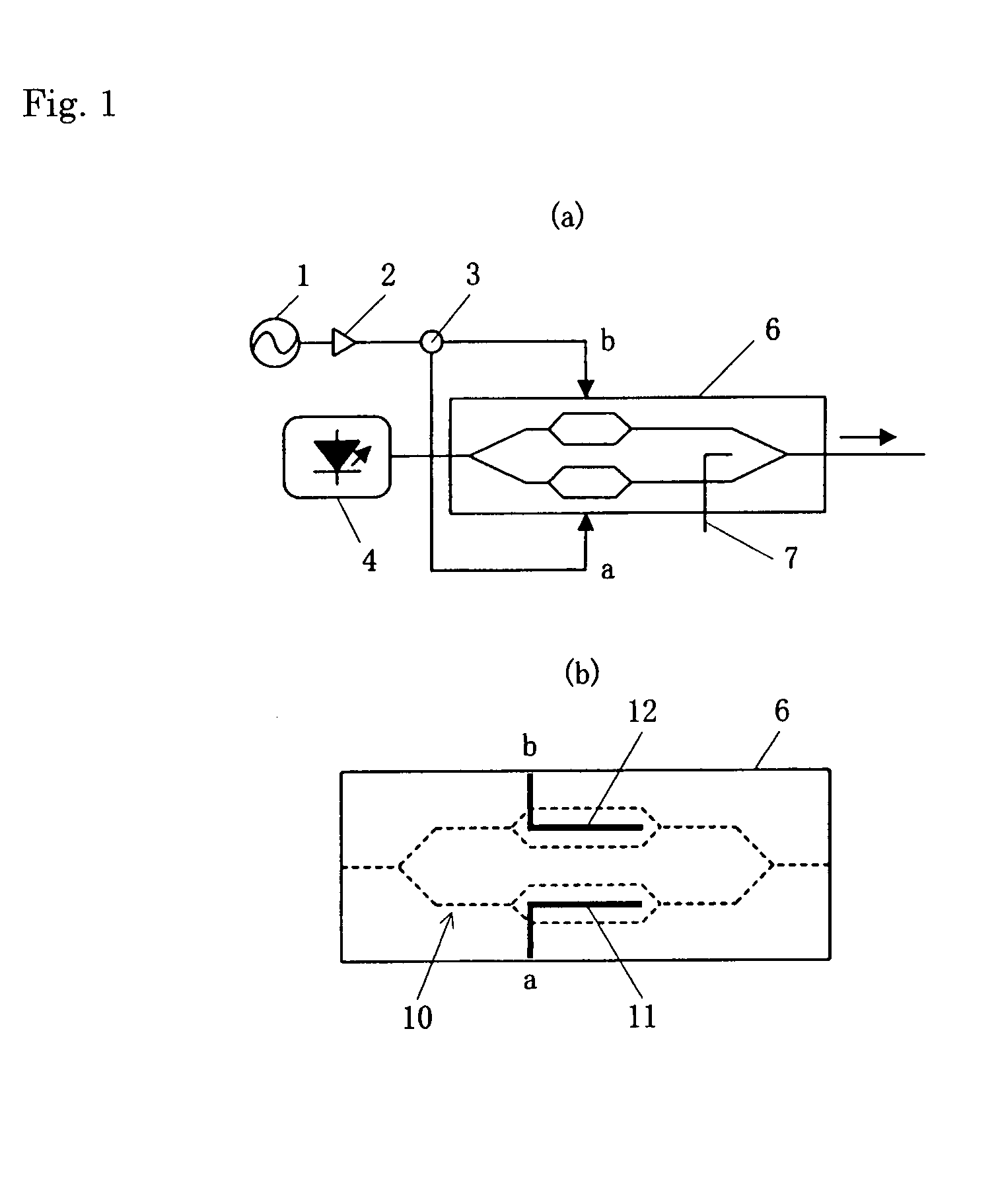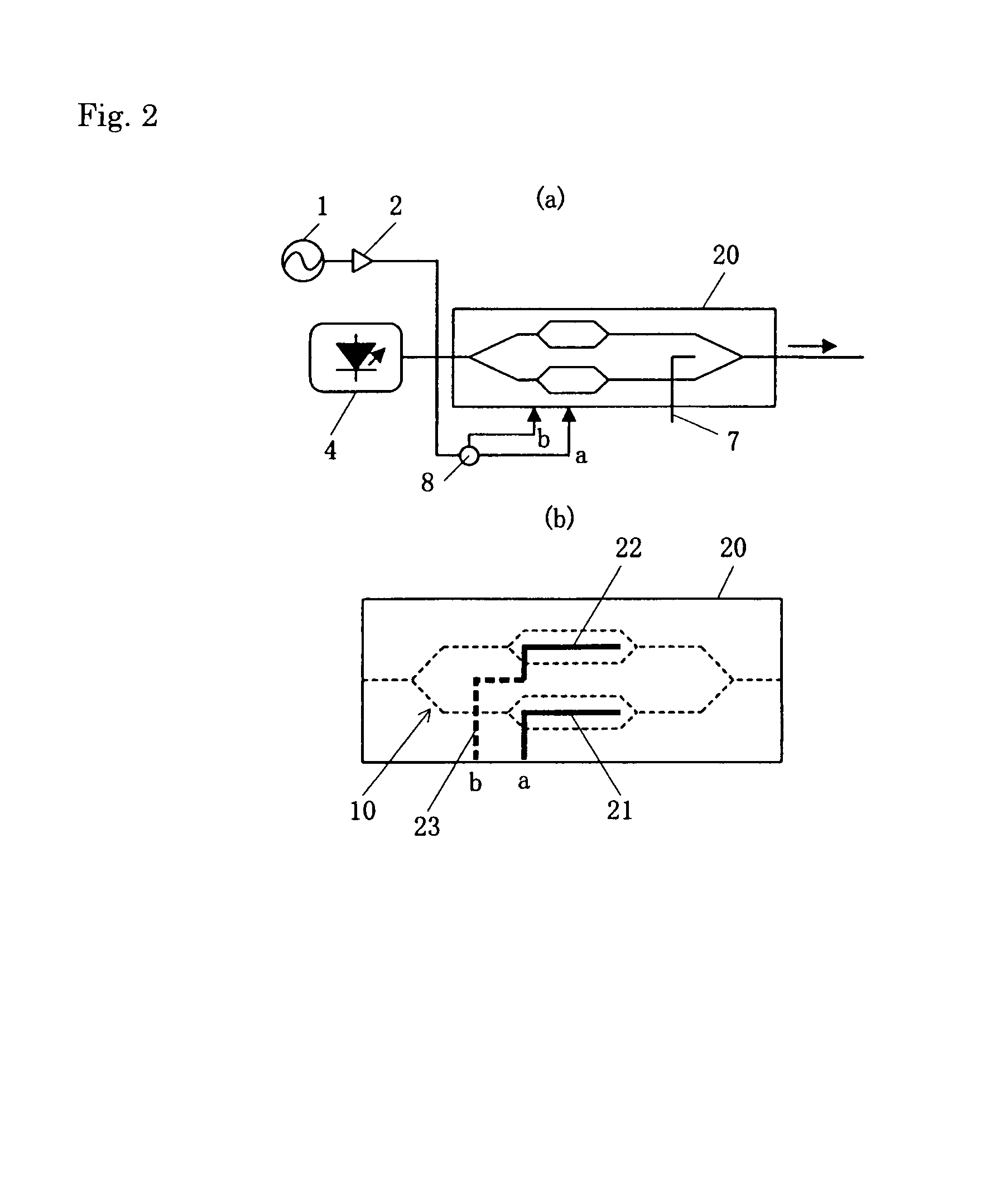Optical modulator
a technology of optical modulator and delay circuit, which is applied in the field of optical modulator, can solve the problems of increasing the cost of the entire optical modulator, increasing the setting space of the delay circuit, and complicated configuration, and achieves the effect of high phase difference accuracy and space saving
- Summary
- Abstract
- Description
- Claims
- Application Information
AI Technical Summary
Benefits of technology
Problems solved by technology
Method used
Image
Examples
second embodiment
[0049]the present invention is shown in FIG. 3.
[0050]In FIGS. 3. a branch element such as a frequency divider is not provided outside of an SSB-type optical modulator 30. A T-type electrode 34, which is a branch element, and a delay line 35 are provided within the optical modulator 30, so as to apply identical modulation signals having a phase difference of 90° into modulation electrodes 32 and 33 as shown in FIG. 38. Reference numeral 31 denotes an introduction line of modulation signal into the T-type electrode 34.
[0051]As the configuration of the T-type electrode, it is preferable to match impedances of a junction as disclosed in Patent Document 1.
[0052][Patent Document 1]
[0053]Japanese Patent Laid-open Publication No. 2004-163859
[0054]By forming the T-type electrode and the delay line in combination on the substrate of the optical modulator 30 as shown in FIG. 3, the external branch element becomes unnecessary, and only one modulation signal is required to be inputted into the o...
third embodiment
[0055]Next, the present invention is shown in FIG. 4.
[0056]In the third embodiment, delay lines like the one shown in FIG. 2 are formed on relaying boards 41 and 43 provided outside of the substrate of an SSB-type optical modulator 40. In particular, the lengths of delay lines 42 and 44 respectively formed on the relaying boards 41 and 43 are differentiated, whereby a predetermined phase difference is generated. The use of relaying boards as stated above enables the conventional type of optical modulator shown in FIG. 1 to be used as the SSB-type optical modulator 40.
[0057]A plurality of relaying boards with delay lines of different lengths may be prepared as the relaying board 41 or 43, and combined in accordance with the necessary phase difference. The SSB-type optical modulator 40, relaying boards 41 and 43 may be housed in one case to be a single module. In this case, SSB modulation can be achieved by guiding two in-phase modulation signals generated by the frequency divider 8 a...
fourth embodiment
[0058]the present invention is shown in FIG. 5.
[0059]The fourth embodiment uses a relaying board 51 provided outside of the substrate of an SSB-type optical modulator 50 like the third embodiment. A T-type electrode 52 formed on the relaying board 51 allows omission of the frequency divider 8 of FIG. 4A. In the fourth embodiment, the delay line 23 is provided within the SSB-type optical modulator 50 like the first embodiment shown in FIG. 2. The use of such relaying board 51 enables only one modulation signal to be inputted.
[0060]By forming a delay line 55 like the delay line 44 in FIG. 4B as well as the T-type electrode 54 on a relaying board 53 as shown in FIG. 5C, the delay line 55 on the relaying board 53 may be endowed with the delay function of the delay circuit 23 partly or entirely.
[0061]Next, a method of adjusting the delay amount of the relaying board is explained.
[0062]When operating frequencies are different, it is necessary to change the delay amount in accordance with ...
PUM
| Property | Measurement | Unit |
|---|---|---|
| phase | aaaaa | aaaaa |
| specific phase difference | aaaaa | aaaaa |
| specific phase | aaaaa | aaaaa |
Abstract
Description
Claims
Application Information
 Login to View More
Login to View More - R&D
- Intellectual Property
- Life Sciences
- Materials
- Tech Scout
- Unparalleled Data Quality
- Higher Quality Content
- 60% Fewer Hallucinations
Browse by: Latest US Patents, China's latest patents, Technical Efficacy Thesaurus, Application Domain, Technology Topic, Popular Technical Reports.
© 2025 PatSnap. All rights reserved.Legal|Privacy policy|Modern Slavery Act Transparency Statement|Sitemap|About US| Contact US: help@patsnap.com



